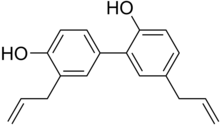 | |
| Names | |
|---|---|
| Preferred IUPAC name
3′,5-Di(prop-2-en-1-yl)[1,1′-biphenyl]-2,4′-diol | |
| Other names
houpa, hnk
| |
| Identifiers | |
3D model (JSmol)
|
|
| ChEMBL | |
| ChemSpider | |
| ECHA InfoCard | 100.122.079 |
| KEGG | |
PubChem CID
|
|
| UNII | |
CompTox Dashboard (EPA)
|
|
| |
| |
| Properties | |
| C18H18O2 | |
| Molar mass | 266.334 g/mol |
| Appearance | White solid |
| sparingly (25 °C) | |
| Related compounds | |
Related biphenols
|
diethylstilbestrol, dihydroxyeugenol |
Related compounds
|
magnolol. 4-O-Methylhonokiol |
Except where otherwise noted, data are given for materials in their standard state (at 25 °C [77 °F], 100 kPa).
| |
Honokiol is a lignan isolated from the bark, seed cones, and leaves of trees belonging to the genus Magnolia. It has been identified as one of the chemical compounds in some traditional eastern herbal medicines along with magnolol, 4-O-methylhonokiol, and obovatol.
